When everything gets still in the house, you pick up on plenty of sounds. Your cat batting around their favorite catnip toy. The windchime out on the porch. Ice clinking in your glass. And the unmistakable sound of your dog licking their paws. How long have they been licking and biting at their toes? A few moments or the better part of an hour? Occasional biting and licking at paw pads doesn’t raise too many concerns. But when the behavior shows up out of the blue or turns into a habit, it’s time to take notice. Because the reasons for dogs licking their paws? They’re varied, and each one requires a different form of treatment.
Dog Behavior
We don’t usually pay attention when cats begin grooming themselves. That’s normal cat behavior. But we don’t think the same for dogs. We should, though. Dogs perform grooming, too – just not to the same extent as cats. And that’s why dogs licking their paws catch our attention so easily. It doesn’t fit into their usual routine (most of the time).
According to Dr. Christopher Pachel, the owner of Animal Behavior Clinic, the nibbling behavior usually signals an itch of some kind. After all, canines lack opposable thumbs. That means they need to resort to using their tongue and teeth to reach anything that feels out of place on their paws. Unfortunately, pinning down the SOURCE of that itch isn’t the easiest thing in the world. “It can be multiple different things. This is not a ‘one size fits all,'” admits Dr. Pachel.
And that’s where your observational skills come into play. As soon as you notice your dog licking their paws, you need to start taking notes. This goes double if they’ve never done so before – or if it’s becoming a frequent or extended habit.
Dog Licking Their Paws
When a dog starts licking their paws, you’ll find two primary causes: visual and non-visual. Either way, it’s a good idea to make an appointment with your vet to have your pup checked. Because as the behavior continues? The potential exists for lick granulomas to develop. Lick granulomas are wounds created by excessive licking of the feet. Whether your dog’s trying to reach a flea between their toes or cope with anxiety, all of that nibbling can lead to a GENUINE problem. So when your internal “Dog Parent” alert goes off, get on the phone right away.
Then you can start taking down those notes about what you’re seeing (or not seeing, as the case may be).
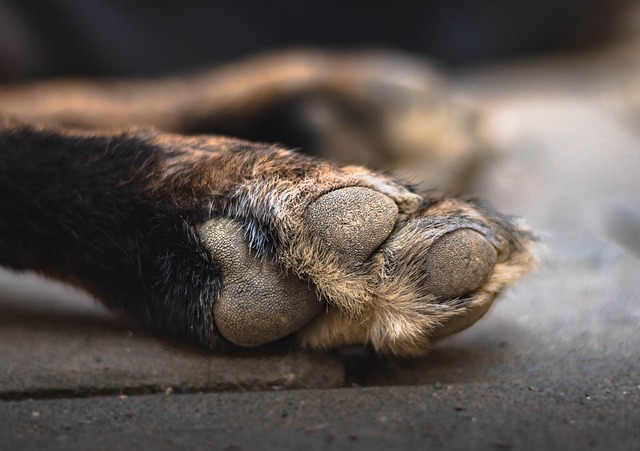
Visual Reasons for a Dog Licking Their Paws
With no opposable thumbs, dogs resort to their teeth to reach injuries or irritations on and around their toes. And this can be ANYTHING. They pick up foreign bodies (i.e., plastic, glass, or splinters) while they’re outside. Or they can end up with burns from walking on hot pavement. On the flip side, chemicals from snow and ice melters can lead to their own kind of burns. And then you have natural health changes that can change the way paw and toe pads feel, driving your poor dog crazy.
These are a FEW of the visual issues that can prompt your do to lick their paws:
- Burns
- Cancerous tumors
- Corns
- Dermatitis (dry skin)
- Fleas or ticks
- Foreign bodies
- Fractured nails
- Interdigital cysts
- Mites
- Puncture wounds
- Rashes
Diagnosis
Obviously, it’s pretty easy to lift your dog’s paw and take a look for these things. You’ll see redness, swelling, bleeding, or the objects themselves. Or you’ll notice your dog limping (or whimpering and refusing to get up). In addition to your dog licking their paws, they’ll provide a sign of pain.
If you have a pup with fluffy toes, you may need to trim the excess hair back to get a good look at what’s going on. And all of that long hair may be the problem. Fur can grab hold of grass awns, burrs, or even pesky ticks and trap them against the paw pads. Not to mention hair rubbing against sensitive toes? That’s pretty itchy.
Even if you see the source of the problem, though, you still want to have a vet evaluate your dog. If there are wounds present, they need to treat your dog for possible infection. After all, your dog licking their paws? That introduces bacteria into the cut or burn. And you don’t want to complicate healing with a new infection.
Non-Visual Reasons for a Dog Licking Their Paws
Unhappily, you also see plenty of reasons for a dog licking their paws that don’t show up on the surface. (So, you don’t actually SEE them) And they’re not all benign, either. This is why it’s so important to make that appointment to have a veterinarian check your poor pup. You don’t want to overlook something important, thinking you’re only dealing with a behavioral issue.
None of these conditions will show on the surface (well, other than that licking/biting issue):
- Allergies
- Anxiety
- Arthritis
- Autoimmune diseases
- Boredom
- Cancer (yeah, it creeps in there again)
- Canine compulsive disorder
A Note on Canine Allergies
Canine allergies tend to be one of the biggest culprits of a dog licking their paws. And the fact that the environment causes most allergy flares? That’s why. Dogs can pick up allergens from almost anything they touch, including grass, dust, mites (the dust mites that live on EVERYTHING), and insects. And that doesn’t begin to include any special chemicals in the soaps or air fresheners you might have around the house.
Like us, dogs can have seasonal OR year-round allergies. This means you might see that paw-nibbling behavior waxing and waning (or going on whether it’s sunny or snowing). And if you don’t visit your vet for allergy testing? Your poor pup could end up miserable, trying to chew their feet off.
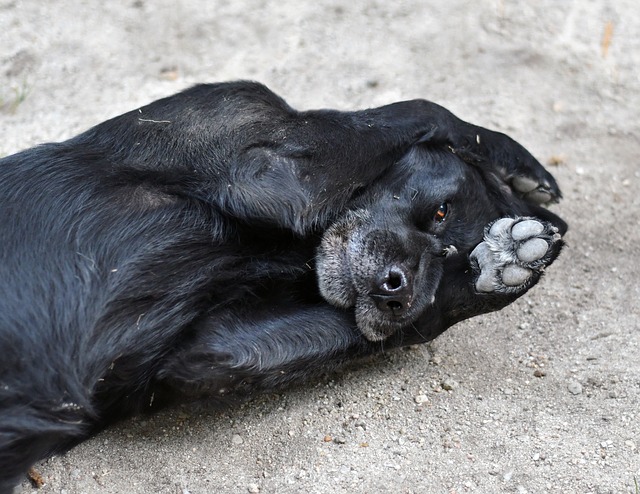
The Behavior Angle
Plenty of dogs take to licking their paws due to behaviors. They’re bored with their current living situation, or they might have separation anxiety. Why does that translate to biting at their toes? It’s actually pretty simple. At some point in the past, licking a paw pad brought comfort. Maybe they had an itch. Or perhaps they nipped to remove a piece of grass from between their toes. Whatever the reason, their brains tagged the memory as an action that brought a sense of “I feel better.”
And now they’re using the behavior to cope with something negative. It’s a way to “feel better.”
Unfortunately, when a dog licking their paws becomes compulsive, you may struggle to break the habit. If your vet rules out any health condition, you need to look at what’s going on around the house. Hopefully, before a lick granuloma forms, leading to infections and pain for your poor pup. (Not to mention encouraging MORE licking!)
Working through compulsive behaviors may require the intervention of a professional trainer or behaviorist. They’ll help you design a training program to wean your dog away from that bad chewing/licking habit. Sometimes it’s as easy as providing alternative stimulation (such as puzzle toys). Other times? You need to get to the root of why your dog is so anxious.
Preventing Your Dog Licking Their Paws
You may not always have full control over your dog’s licking or chewing behaviors. If there are underlying medical conditions? You need the assistance of your vet to keep things in check. But you CAN help keep your dog as comfortable as possible by ensuring those cute little toes stay healthy. And if you follow these helpful hints? You may not see your dog licking their paws quite as often:
- Paw Cleaning: Whenever your dog comes inside? Do a quick swipe with a grooming wipe. Not only will you remove potential allergens or debris, but you’ll have a chance to examine those paw pads for any foreign bodies or pests.
- Climate Control: Summer and winter have the potential to lead to skin irritation. If you stay on top of your thermostat during hot weather and bring in a humidifier during cold snaps? You’ll keep those tootsies comfy.
- Foot Protection: The outside world is harsh on paws. You may need to consider dog shoes when your furry friend goes on walks. Or you can apply soothing balms afterward as a “spa” treatment.
- Grooming Schedule: You have a bathing schedule for your dog – and that’s important. But you want to do the same for their beds and the rest of the house. Use cleaners WITHOUT scents or harsh chemicals to prevent allergy flares.
And, of course, as soon as you feel there’s a problem? Head to the vet. They’ll help start the proper treatment.
Lickety-Split
When your dog pauses to clean their feet now and then? It probably slides under the radar. But you notice when they spend the afternoon biting at their toes. And a dog licking their feet CAN signal a serious health concern. Whether it’s a group of seed ticks hiding out between the toes (yes, it happens), a flare-up of allergies, or a compulsion due to a smart pup that’s bored around the house, you want to intervene and find a solution. Scheduling an appointment with your vet is the first step.
Once you know the source of the problem? Then you can work toward treatment. But doing quick checks of those cute little doggie toes will help you stay on top of the problem.
Besides, who doesn’t want to look at cute puppy paws?


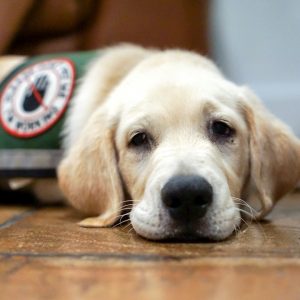


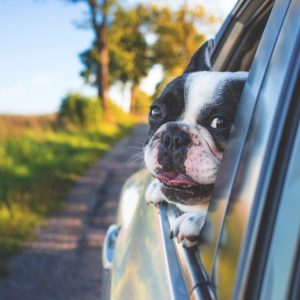
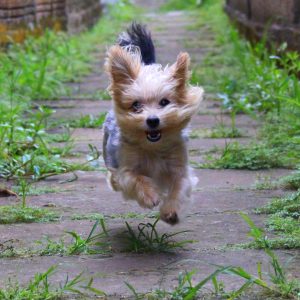

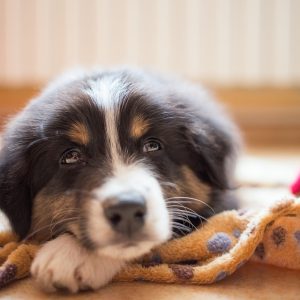

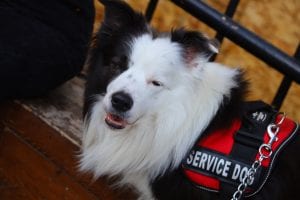


No comment yet, add your voice below!